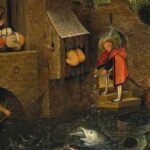
When visiting the Palace of Versailles in Paris, it is observed that the sumptuous palace has no bathrooms.
In the Middle Ages, there were no toothbrushes, perfumes, deodorants, and much less toilet paper.
Human excrements were thrown out of palace windows.
On a holiday, the palace kitchen was able to prepare a feast for 1500 people, without the minimum hygiene.
In today’s movies we see people from that era shaking or fanning…
The explanation is not in the heat, but in the foul odor emitted under the skirts (which were deliberately made to contain the smell of private parts, since there was no hygiene). It was also not customary to shower due to the cold and the almost non-existence of running water.
Only the nobles had lackeys to fan them, to dispel the bad odor that exhalated the body and mouth, as well as to scare away the insects.
Those who have been to Versailles have admired the huge and beautiful gardens that, at that time, were not only contemplated, but used as a toilet in the famous ballads promoted by the monarchy, because there were no bathrooms.
In the Middle Ages, most weddings took place in June (for them, the beginning of summer).
The reason is simple: the first bath of the year was taken in May; so, in June, the smell of people was still tolerable.
However, as some odors were already beginning to bother, the brides carried bouquets of flowers near their bodies to cover the odor.
Hence the explanation of the origin of the bridal bouquet.
The baths were taken in a single massive tub filled with hot water.
The head of the family had the privilege of the first swim in clean water.
Then, without changing the water, the others arrived in the house, in order of age, women, also by age and finally, children.
The babies were the last ones to bathe. When his turn came, the water in the bathtub was so dirty that it was possible to kill a baby inside.
Hence the phrase “throwing out the baby with the bath water”
The roofs of the houses had no sky and the wooden beams that held them up were the best place for animals: dogs, cats, rats and cockroaches to keep warm.
When it rained, leaks forced the animals to jump to the ground.
Those who had money had tin plates. Certain types of food oxidized the material, causing many people to die from poisoning.
Let’s remember that the hygiene habits of the time were terrible.
Tomatoes, being acidic, were considered poisonous for a long time, can cups were used to drink beer or whiskey; this combination, sometimes, left the individual “on the floor” (in a kind of narcolepsy induced by mixing alcoholic beverage with tin oxide).
Someone passing by the street would think he was dead, so they were picking up the body and preparing for the funeral.
Then the body would be placed on the kitchen table for a few days and the family would stand watching, eating, drinking and waiting to see if the dead man would wake up or not.
Hence the wake of the dead, which is the vigil next to the coffin.
England is a small country, where there wasn’t always a place to bury all the dead.
Then the coffins were opened, the bones were extracted, they were placed in rosaries and the grave was used for another corpse.
Sometimes, when opening the coffins, you could notice scratches on the lids inside, indicating that the dead man had, in fact, been buried alive.
Thus, when closing the coffin, the idea came to tie a strip of the deceased’s wrist, pass it through a hole made in the coffin and tie it to a bell.
After the burial, someone stayed on duty next to the grave for a few days.
If the individual woke up, the movement of his arm would ring the bell.
And it would be “saved by the bell,” an expression used by us to this day.










Leave a Reply